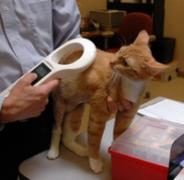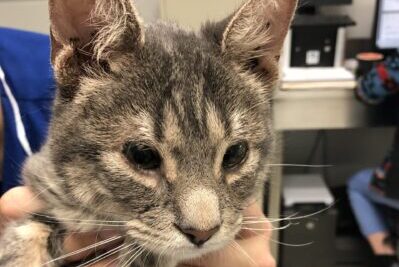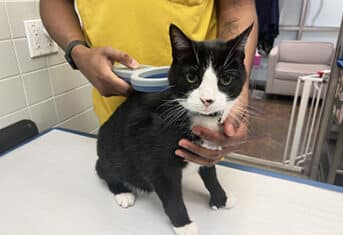Collars and Chips for All Cats

Collars and Chips for All Cats
Without research into disease mechanisms, new diagnostic tests and better treatments, there would be no advances in the medical care of either animals or people. Yet some folks think all animal research is bad. Let me tell you about some recently published research that just might save your cat’s life. The Journal of the American Veterinary Medical Association has published a study “Evaluation of collars and microchips for visual and permanent identification of pet cats.” Since cats are now more popular pets than dogs are, this research is really important to those of us who love cats.
The lack of identification — either by a collar or microchip — is the main reason a cat’s owner cannot be found. Both indoor and outdoor cats can be lost and end up in a shelter so this study applies to all pet cats. Unfortunately, when cats end up in a shelter they are frequently euthanized if the owner cannot be found, making the question asked in this study, “What is the best method of identifying a lost cat, is it a collar or a microchip?” a matter of life and death.
The owners of 538 pet cats in Ohio, New York, Florida and Texas gave permission for their cats to participate in this creative study. All cats had a microchip placed for permanent identification and each cat wore a collar. To determine which collar would stay on the cat and provide the best opportunity for a cat’s owner to be identified, three different collars were evaluated in the study: a plastic buckle collar, a breakaway plastic buckle safety collar and an elastic stretch safety collar. Owners were surveyed at the beginning and the end of the 6 month study.
As you might expect, the microchips performed extremely well. All but one was working well after 6 months, providing a ready method of cat owner identification. This information reinforces the need for every cat (and by the way, dogs too!) to have a microchip placed. But because this study identified a microchip failure, all cat owner’s should have their cat’s microchip function confirmed during an annual examination. This takes barely a second or two.
Not surprisingly, collars were less reliable than microchips, but they were still effective in identifying a cat. Just over 70% of cats wore their collars successfully for the duration of the study, underscoring the importance of the microchip as a backup method of identification. Owners frequently had to replace all types of collars, but the plastic buckle collar stayed on the best. No collar related injuries were identified, although 3.8% of cats did get the collar caught on an inanimate object or a body part such as their leg or mouth.
Cat owners, this is your call to action. Researchers have provided you with the tools to save your cat’s life. All you need to do is get your favorite feline a collar and a chip.
Source: Journal of the American Veterinary Medical Association 2010:237:387-394. Evaluation of collars and microchips for visual and permanent identification of pet cats. Lord LK, Griffin B, Slater MR, Levy JK.
This blog may also be found in the “Tales from the Pet Clinic” blog from WebMD.
_________________________________________________
For nearly a century, The Animal Medical Center has been a national leader in animal health care, known for its expertise, innovation and success in providing routine, specialty and emergency medical care for companion animals. Thanks in part to the enduring generosity of donors, The AMC is also known for its outstanding teaching, research and compassionate community funds. Please help us to continue these efforts. Send your contribution to: The Animal Medical Center, 510 East 62nd Street, New York, NY 10065. For more information, visit https://www.amcny.org/. To make an appointment, please call 212.838.7053.


































